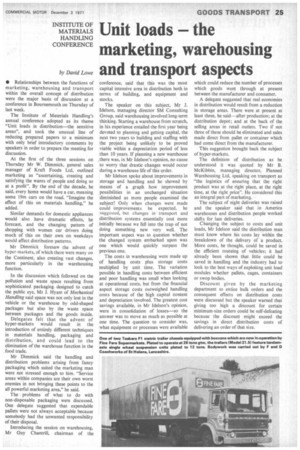Unit loads the marketing, warehousing and transport aspects
Page 27

If you've noticed an error in this article please click here to report it so we can fix it.
by David Lowe
• Relationships between the functions of marketing, warehousing and transport within the overall concept of distribution were the major basis of discussion at a conference in Bournemouth on Thursday of last week.
The Institute of Materials Handling's annual conference adopted as its theme "Unit loads in distribution—the sensitive areas", and took the unusual line of reducing prepared papers to a minimum with only brief introductory comments by speakers in order to prepare the meeting for discussion.
At the first of the three sessions on Thursday Mr W. Dimmick, general sales manager of Kraft Foods Ltd, outlined marketing as "ascertaining, creating and satisfying the wants of people and doing so at a profit". By the end of the decade, he said, every home would have a car, meaning some 19m cars on the road. "Imagine the effect of this on materials handling," he added.
Similar demands for domestic appliances would also have dramatic effects, he forecast, and the changing pattern of shopping with women car drivers doing much of this on their own on weekdays would affect distribution patterns.
Mr Dimmick foresaw the advent of hyper-markets, of which there were many on the Continent, also creating vast changes, more particularly in the warehousing function.
In the discussion which followed on the pollution and waste space resulting from sophisticated packaging designed to catch the public eye, Mr J. Hyam of Mechanical Handling said space was not only lost in the vehicle or the warehouse by odd-shaped packages but also by the waste space between packages and the goods inside.
Delegates felt that the advent of hyper-markets would result in the introduction of entirely different techniques in materials handling, packaging and distribution, and could lead to the elimination of the warehouse function in the food trade.
Mr Dimmick said the handling and distribution problems arising from fancy packaging which suited the marketing man were not stressed enough to him. "Service areas within companies are their own worst enemies in not bringing these points to the all powerful marketing area," he said.
The problems of what to do with non-disposable packaging were discussed. One delegate suggested that expendable pallets were not always acceptable because somebody had the unwanted responsibility of their disposal.
Introducing the session on warehousing, Mr Guy Chantrill, chairman of the conference, said that this was the most capital intensive area in distribution both in terms of building, and equipment and stocks.
The speaker on this subject, Mr J. Idelson, managing director SM Consulting Group, said warehousing involved long-term thinking. Starting a warehouse from scratch, in his experience entailed the first year being devoted to planning and getting capital, the next two years to building and staffing with the project being unlikely to be proved viable within a depreciation period of less than 10 years. If planning a new warehouse there was, in Mr Idelson's opinion, no cause to worry that drastic changes would occur during a warehouse life of this order.
Mr Idelson spoke about improvements in storage and handling and he showed by means of a graph how improvement possibilities in an unchanged situation diminished as more people examined the subject! Only when changes were made could improvements be expected, he suggested, but changes in transport and distribution systems essentially cost more initially because we fell into the trap of not doing something new very well. The important aspect was to question whether the changed system embarked upon was one which would quickly surpass the previous one.
The costs in warehousing were made up of handling costs plus storage costs multiplied by unit time. The variation possible in handling costs between efficient and poor handling was small when looking at operational costs, but from the financial aspect storage costs outweighed handling costs because of the high capital content and depreciation involved. The greatest cost savings available, in Mr Idelson's opinion, were in consolidation of losses—so the answer was to move as much as possible at one time. The question to consider was, what equipment or processes were available which could reduce the number of processes which goods went through at present between the manufacturer and consumer.
A delegate suggested that real economies in distribution would result from a reduction in storage areas. There were at present at least three, he said—after production; at the distribution depot; and at the back of the selling areas in retail outlets. Two if not three of these should be eliminated and sales made direct from pallet or container which had come direct from the manufacturer.
This suggestion brought back the subject of hyper-markets.
The definition of distribution as he understood it was quoted by Mr B. McKibbin, managing director, Planned Warehousing Ltd, speaking on transport as "the logistics of ensuring that the right product was at the right place, at the right time, at the right price". He considered this an integral part of marketing.
The subject of night deliveries was raised and the speaker said that in America warehouses and distribution people worked shifts for late deliveries.
Changing the subject to costs and unit loads, Mr Idelson said the distribution man must know where his costs lay within the breakdown of the delivery of a product. More costs, he thought_ could be saved in the efficient routeing of vehicles; it had already been shown that little could be saved in handling and the industry had to look to the best ways of exploiting unit load modules whether pallets, cages, containers or swop bodies.
Discount given by the marketing department to entice bulk orders and the consequent effects on distribution costs were discussed but the speaker warned that giving too high a discount for certain minimum-size orders could be self-defeating because the discount might exceed the savings in direct distribution costs of delivering an order of that size.


































































































































